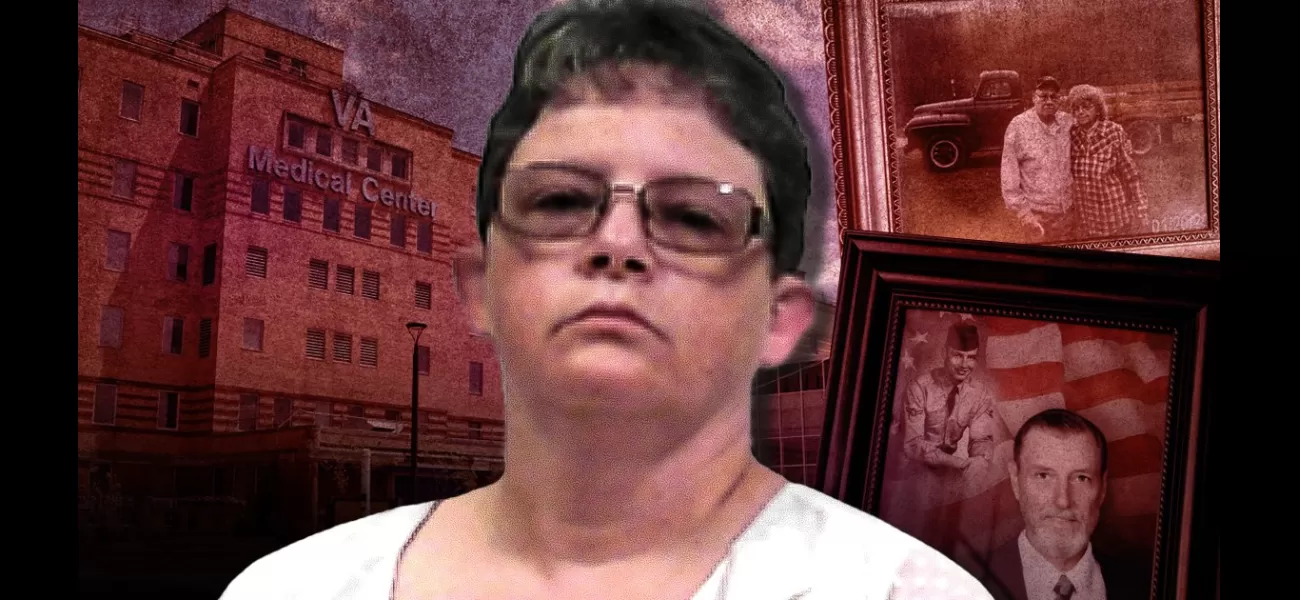A killer disguised as a hospital employee terrorized the building without anyone suspecting.
The 'Angel of Death' targeted and killed her fellow veterans.
April 22nd 2024.

In a shocking court hearing, Reta Mays, also known as the "Angel of Death", was finally brought to justice for her heinous crimes. The 46-year-old had been sentenced to life in prison for carrying out a killing spree at the Veterans Affairs medical center in Clarksburg, West Virginia. As she was being handcuffed, Mays broke down in tears, seemingly overwhelmed by the gravity of her actions.
Mays' violent rampage had claimed the lives of seven people, all of whom were fellow veterans aged between 81 and 96. These brave men had served their country in Korea, Vietnam, and World War Two, only to be tragically killed by someone who was supposed to care for them. The motive behind Mays' actions remains a mystery, even to this day.
So who was Reta Mays? Born in 1975, she had served in non-combat roles with the West Virginia National Guard and the 1092nd Engineer Battalion. After being honorably discharged in 2005, she worked as a corrections officer for several years before becoming a nursing assistant at the VA Medical Centre in Clarksburg in 2015. Outside of work, she was a member of her local church, giving off the impression of a respectable and upstanding citizen.
However, as author Dominic Utton reveals in his book Faces of Evil, there was a dark side to Mays that few knew about. Her personal life had begun to unravel in 2012 when her husband was arrested on child pornography charges. Despite this, she stood by him, causing shock and outrage in the small West Virginia community. The following year, while working at a regional jail, she was accused of beating an inmate, but the case was dropped before it could go to trial.
It was in the summer of 2017 that Mays' killing spree began. Assigned to work overnight shifts at the VA hospital, she began targeting elderly patients by injecting them with stolen insulin, causing their blood sugar to drop to dangerous levels. Over the next 11 months, six more patients died in mysterious circumstances, with hospital staff attributing their deaths to hypoglycemia.
It wasn't until June 2018 that the suspicious deaths were taken seriously and an investigation was launched. By this time, Mays had become more confident and the pace of her killings had accelerated. But it was only a matter of time before she was caught, as Inspector General Michael Missal received a tip about a possible "Angel of Death" in Clarksburg.
As Dominic explains, Mays' actions were typical of many serial killers. They often start with a large gap between their first and second victims, but as they become more confident and see that they can get away with it, the timeframes between killings become shorter and they become bolder in their actions. In Mays' case, her victims included Felix Kirk McDermott, George Nelson Shaw Sr., Archie Edgell, Robert Edge Sr., Robert Kozul, Raymond Golden, and William Alfred Holloway.
The "Angel of Death" may have thought she could continue her killing spree undetected, but in the end, justice prevailed and she was brought to face the consequences of her actions. As we try to make sense of her twisted mind and the devastating impact she had on so many lives, we are reminded that sometimes the most unsuspecting people can be the most dangerous.
Reta Mays, known as the "Angel of Death," was a nurse who carried out a terrifying killing spree at the Veterans Affairs medical center in Clarksburg, West Virginia. During her trial, she was met with haunting words from the prosecution, "You are the monster no one sees coming." The 46-year-old was ultimately sentenced to life in prison, and as she was being handcuffed, she broke down in tears, burying her head in her hands.
Mays' reign of terror claimed the lives of seven people, all of whom were elderly veterans between the ages of 81 and 96. These brave individuals had served in wars such as Korea, Vietnam, and World War Two. To this day, the motive behind Mays' heinous acts remains a mystery.
But who exactly was Reta Mays? Born in 1975, she had previously served in non-combat roles with the West Virginia National Guard and the 1092nd Engineer Battalion. She was discharged from the military on good terms in 2005 and went on to work as a corrections officer at the North Central Regional Jail in Greenwood, West Virginia. In 2015, she became a nursing assistant at the VA Medical Center in Clarksburg, where her duties included measuring patients' vital signs, changing their sheets, and simply sitting with them. Outside of work, Mays attended the Monroe Chapel United Methodist Church.
According to author Dominic Utton, who wrote a book on Mays' crimes, she lived a secret life. "On paper, she was a really good person," he explains. "But if you picked away at the scab and got past that respectable veneer, you'd see a whole different story." Her life had started to unravel in 2012 when her husband, Gordon, was arrested on child pornography charges. This incident caused shockwaves throughout their small West Virginia community, especially as Mays decided to stand by her husband. The following year, Mays was accused of beating an inmate while working at the North Central Regional Jail. However, the case was dropped before it could reach trial.
So how did Mays carry out her murders? Her victims, including John Hallman, William Holloway, and Archie Dail, were all military veterans. Mays was assigned to work overnight shifts on Ward 3A of the VA hospital in the summer of 2017. Soon after, patients began experiencing sudden drops in blood sugar, known as hypoglycemia. During the time Mays worked at the facility, there were about 20 suspicious deaths, but charges were only brought in cases where there was sufficient evidence.
It was discovered that Mays had been stealing insulin from medication rooms and injecting the elderly veterans with it, causing their blood sugar to drop dangerously low. While insulin is necessary for diabetics, it can be deadly for those who are not prescribed the medication. It wasn't until June 2018 that the string of suspicious deaths began to be taken seriously. By this point, four patients had died within weeks of each other.
According to Dominic, it is common for serial killers to have a larger gap between their first and second victim, followed by a smaller gap and then a "rampage" until they are caught. Mays' first victim was killed in July 2017, and her second in January 2018. As time went on, the timeframes between her murders became shorter, indicating that she was becoming more confident. "Serial killers like Ted Bundy were the same," Dominic adds. "These people get a taste for killing, realize they're getting away with it, and keep going."
Mays' victims included Felix Kirk McDermott, 82, George Nelson Shaw, Sr, 81, Archie Edgell, 84, Robert Edge, Sr, 82, Robert Kozul, 89, Raymond Golden, 88, and 96-year-old William Alfred Holloway. It wasn't until the summer of 2018 that an investigation was finally launched after Inspector General Michael Missal of the Department of Veterans Affairs was informed of a possible "Angel of Death" at the Clarksburg facility.
Dominic's book, Faces of Evil, delves into the lives of serial killers like Mays, exploring their often confusing and mysterious motives. "You think of serial killers as being these evil masterminds, these creative geniuses," he says. But in reality, they can often lead seemingly normal lives, hiding their dark desires and actions beneath a respectable facade. Mays' case is a chilling reminder that evil can lurk in the most unexpected places.
Mays' violent rampage had claimed the lives of seven people, all of whom were fellow veterans aged between 81 and 96. These brave men had served their country in Korea, Vietnam, and World War Two, only to be tragically killed by someone who was supposed to care for them. The motive behind Mays' actions remains a mystery, even to this day.
So who was Reta Mays? Born in 1975, she had served in non-combat roles with the West Virginia National Guard and the 1092nd Engineer Battalion. After being honorably discharged in 2005, she worked as a corrections officer for several years before becoming a nursing assistant at the VA Medical Centre in Clarksburg in 2015. Outside of work, she was a member of her local church, giving off the impression of a respectable and upstanding citizen.
However, as author Dominic Utton reveals in his book Faces of Evil, there was a dark side to Mays that few knew about. Her personal life had begun to unravel in 2012 when her husband was arrested on child pornography charges. Despite this, she stood by him, causing shock and outrage in the small West Virginia community. The following year, while working at a regional jail, she was accused of beating an inmate, but the case was dropped before it could go to trial.
It was in the summer of 2017 that Mays' killing spree began. Assigned to work overnight shifts at the VA hospital, she began targeting elderly patients by injecting them with stolen insulin, causing their blood sugar to drop to dangerous levels. Over the next 11 months, six more patients died in mysterious circumstances, with hospital staff attributing their deaths to hypoglycemia.
It wasn't until June 2018 that the suspicious deaths were taken seriously and an investigation was launched. By this time, Mays had become more confident and the pace of her killings had accelerated. But it was only a matter of time before she was caught, as Inspector General Michael Missal received a tip about a possible "Angel of Death" in Clarksburg.
As Dominic explains, Mays' actions were typical of many serial killers. They often start with a large gap between their first and second victims, but as they become more confident and see that they can get away with it, the timeframes between killings become shorter and they become bolder in their actions. In Mays' case, her victims included Felix Kirk McDermott, George Nelson Shaw Sr., Archie Edgell, Robert Edge Sr., Robert Kozul, Raymond Golden, and William Alfred Holloway.
The "Angel of Death" may have thought she could continue her killing spree undetected, but in the end, justice prevailed and she was brought to face the consequences of her actions. As we try to make sense of her twisted mind and the devastating impact she had on so many lives, we are reminded that sometimes the most unsuspecting people can be the most dangerous.
Reta Mays, known as the "Angel of Death," was a nurse who carried out a terrifying killing spree at the Veterans Affairs medical center in Clarksburg, West Virginia. During her trial, she was met with haunting words from the prosecution, "You are the monster no one sees coming." The 46-year-old was ultimately sentenced to life in prison, and as she was being handcuffed, she broke down in tears, burying her head in her hands.
Mays' reign of terror claimed the lives of seven people, all of whom were elderly veterans between the ages of 81 and 96. These brave individuals had served in wars such as Korea, Vietnam, and World War Two. To this day, the motive behind Mays' heinous acts remains a mystery.
But who exactly was Reta Mays? Born in 1975, she had previously served in non-combat roles with the West Virginia National Guard and the 1092nd Engineer Battalion. She was discharged from the military on good terms in 2005 and went on to work as a corrections officer at the North Central Regional Jail in Greenwood, West Virginia. In 2015, she became a nursing assistant at the VA Medical Center in Clarksburg, where her duties included measuring patients' vital signs, changing their sheets, and simply sitting with them. Outside of work, Mays attended the Monroe Chapel United Methodist Church.
According to author Dominic Utton, who wrote a book on Mays' crimes, she lived a secret life. "On paper, she was a really good person," he explains. "But if you picked away at the scab and got past that respectable veneer, you'd see a whole different story." Her life had started to unravel in 2012 when her husband, Gordon, was arrested on child pornography charges. This incident caused shockwaves throughout their small West Virginia community, especially as Mays decided to stand by her husband. The following year, Mays was accused of beating an inmate while working at the North Central Regional Jail. However, the case was dropped before it could reach trial.
So how did Mays carry out her murders? Her victims, including John Hallman, William Holloway, and Archie Dail, were all military veterans. Mays was assigned to work overnight shifts on Ward 3A of the VA hospital in the summer of 2017. Soon after, patients began experiencing sudden drops in blood sugar, known as hypoglycemia. During the time Mays worked at the facility, there were about 20 suspicious deaths, but charges were only brought in cases where there was sufficient evidence.
It was discovered that Mays had been stealing insulin from medication rooms and injecting the elderly veterans with it, causing their blood sugar to drop dangerously low. While insulin is necessary for diabetics, it can be deadly for those who are not prescribed the medication. It wasn't until June 2018 that the string of suspicious deaths began to be taken seriously. By this point, four patients had died within weeks of each other.
According to Dominic, it is common for serial killers to have a larger gap between their first and second victim, followed by a smaller gap and then a "rampage" until they are caught. Mays' first victim was killed in July 2017, and her second in January 2018. As time went on, the timeframes between her murders became shorter, indicating that she was becoming more confident. "Serial killers like Ted Bundy were the same," Dominic adds. "These people get a taste for killing, realize they're getting away with it, and keep going."
Mays' victims included Felix Kirk McDermott, 82, George Nelson Shaw, Sr, 81, Archie Edgell, 84, Robert Edge, Sr, 82, Robert Kozul, 89, Raymond Golden, 88, and 96-year-old William Alfred Holloway. It wasn't until the summer of 2018 that an investigation was finally launched after Inspector General Michael Missal of the Department of Veterans Affairs was informed of a possible "Angel of Death" at the Clarksburg facility.
Dominic's book, Faces of Evil, delves into the lives of serial killers like Mays, exploring their often confusing and mysterious motives. "You think of serial killers as being these evil masterminds, these creative geniuses," he says. But in reality, they can often lead seemingly normal lives, hiding their dark desires and actions beneath a respectable facade. Mays' case is a chilling reminder that evil can lurk in the most unexpected places.
[This article has been trending online recently and has been generated with AI. Your feed is customized.]
[Generative AI is experimental.]
0
0
Submit Comment





